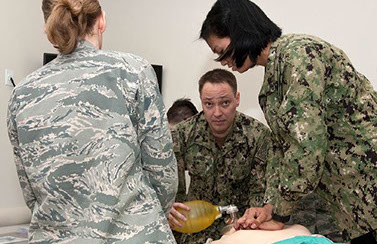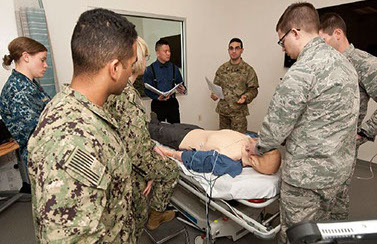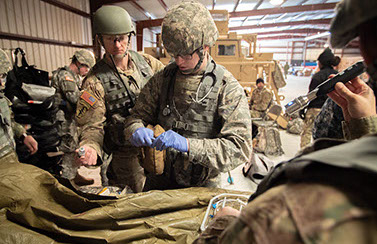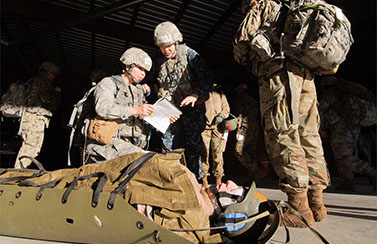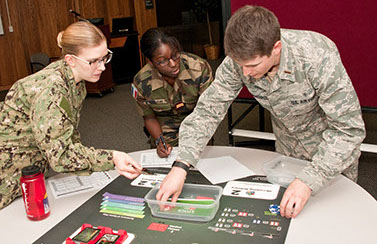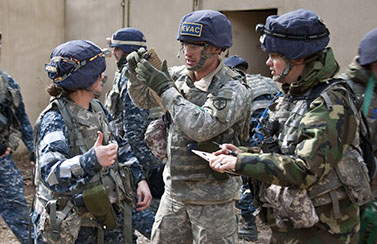OVERVIEW
No other medical school in the United States prepares students for the challenges of providing high-quality care in any setting with limited or unclear information using minimal equipment and supplies. Building on the concepts and principles taught in the pre-clerkship curriculum {link to previous page}, and following completion of the required clinical clerkships, the post-clerkship military-unique curriculum focuses on providing excellent clinical capabilities, superior joint health services planning and support, and outstanding team and organizational leadership. The post-clerkship curriculum is comprised of Medical Field Practicum 201, Medical Field Practicum 202, and their respective preparatory curricula plus the American Red Cross Advanced Life Support (ALS) Course. Students also take the American College of Surgeons Advanced Trauma Life Support (ATLS) Course offered by the Department of Surgery. These pairs of courses combine to ensure competence in out-of-hospital forward resuscitative care (FRC) and in-hospital initial assessment and management of many life-threatening emergencies, respectively.
ADVANCED LIFE SUPPORT
Students learn the essential skills of Advanced Life Support (ALS) using a blended curriculum from the American Red Cross. Basic and advanced airway management skills are acquired, electrocardiographic rhythm interpretation is taught, and cardioversion and defibrillation are practiced. Students learn the immediate lifesaving management of compromising bradycardic rhythms, unstable tachycardic rhythms, and approach to a variety of rhythms leading to cardiac arrest. Students gain essential skills in crisis communication, team leadership, task delegation, and debriefing to effectively run a resuscitation.
MILITARY MEDICINE 200
Following the ALS and ATLS courses, the integrated post-clerkship module, Military Medicine 200, begins with one day of hands-on experiences before Medical Field Practicum 201 “Operation Gunpowder” as the primary military field medicine and military medical practice component. Students apply clinical skills acquired during their core clinic and hospital clerkships to a medically austere setting they may face in the future. Forward Resuscitative Care and Prolonged Field Care with minimal resources are major emphases of the course. Exposure to the chain of survival through the capabilities through the Joint En-Route Care System is another. The military medical leadership component of Military Medicine 200 includes team dynamics under stress, risk communications, organizational and strategic communications, intercultural communications, decision-making under ethical dilemmas, and much more.
MILITARY CONTINGENCY MEDICINE
Military Contingency Medicine (MCM) is the only consolidated course taught by the Department of Military & Emergency Medicine. It is the culminating educational activity for the USU School of Medicine’s four-year integrated curriculum across all disciplines of military field medicine, military medical practice, military medical leadership, and multiple other courses of study, disciplines, specialties, and cross-professional interactions that contribute to the formation of a professional and high-performing uniformed medical officer. MCM is a three-week course featuring two weeks of classes, small-group discussions, table-top exercises, and process walkthroughs prior to a notional deployment on “Operation Bushmaster” – a five-day medical field practicum. Students from the Graduate School of Nursing and select medical students from international partners also attend MCM and Medical Field Practicum 202.
Skills in military emergency medicine are enhanced through discussions related to trauma more commonly encountered during deployments, such as ballistic and blast injuries, and other issues such as combat stress; triage and mass-casualty management; care of the military working dog; management of dental, musculoskeletal, and mental-health problems; techniques and strategies for pain management; and a variety of environmental injuries.
Knowledge in military medical practice are expanded by lectures on and exercises involving health and physical safety risk assessments; troop-leading procedures and military decision-making processes; planning for joint health services in contested environments; casualty estimation and distribution; Force Health Protection measures, as well as epidemiological investigations of illness and injury trends; scenarios requiring familiarity with the Law of Armed Conflict; and missions involving Global Health Engagement, Disaster Response and Humanitarian Assistance, and Stability Operations.
Abilities in military medical leadership are enriched by discussions on interprofessional and intercultural communications; military briefing and risk communications; and working with the media to support strategic goals.

